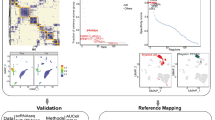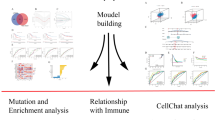Abstract
Immunotherapy has greatly changed the status of cancer treatment, and many patients do not respond or develop acquired resistance. The related research is blocked by lacking of comprehensive resources for researchers to discovery and analysis signatures, then further exploring the mechanisms. Here, we first offered a benchmarking dataset of experimentally supported signatures of cancer immunotherapy by manually curated from published literature works and provided an overview. We then developed CiTSA (http://bio-bigdata.hrbmu.edu.cn/CiTSA/) which stores 878 entries of experimentally supported associations between 412 signatures such as genes, cells, and immunotherapy across 30 cancer types. CiTSA also provides flexible online tools to identify and visualize molecular/cell feature and interaction, to perform function, correlation, and survival analysis, and to execute cell clustering, cluster activity, and cell–cell communication analysis based on single cell and bulk datasets of cancer immunotherapy. In summary, we provided an overview of experimentally supported cancer immunotherapy signatures and developed CiTSA which is a comprehensive and high-quality resource and is helpful for understanding the mechanism of cancer immunity and immunotherapy, developing novel therapeutic targets and promoting precision immunotherapy for cancer.





Similar content being viewed by others
Data availability
The datasets generated and/or used during the current study are available in the Gene Expression Omnibus (https://www.ncbi.nlm.nih.gov/geo/), The Cancer Genome Atlas (https://portal.gdc.cancer.gov/), and we also develop database, CiTSA (http://bio-bigdata.hrbmu.edu.cn/CiTSA/).
Abbreviations
- BRCA:
-
Breast cancer
- CAN:
-
Copy number alteration
- COCA:
-
Colon cancer
- FC:
-
Fold change
- GBM:
-
Glioma
- HNSC:
-
Head and neck cancer
- LUCA:
-
Lung cancer
- MM:
-
Myeloma
- NSCLC:
-
Non-small cell lung cancer
- OS:
-
Overall survival
- R/NR:
-
Immunotherapy response/no response
- SKCM:
-
Skin melanoma
- STAD:
-
Gastric cancer
- T/NT:
-
Immunotherapy treatment/no treatment
- TCGA:
-
The Cancer Genome Atlas
- TMB:
-
Tumor mutation burden
- TME:
-
Tumor microenvironment
References
Huang AC, Zappasodi R (2022) A decade of checkpoint blockade immunotherapy in melanoma: understanding the molecular basis for immune sensitivity and resistance. Nat Immunol 23:660–670
Kalaora S, Nagler A, Wargo JA, Samuels Y (2022) Mechanisms of immune activation and regulation: lessons from melanoma. Nat Rev Cancer 22:195–207
Herbst RS, Wang M, Chen L (2022) When immunotherapy meets surgery in non-small cell lung cancer. Cancer Cell 40:603–605
Foronda M (2021) Front-line immunotherapy combinations for gastric cancer. Nat Cancer 2:1286
Takei S, Kawazoe A, Shitara K (2022) The New era of immunotherapy in gastric cancer. Cancers (Basel) 14:1054
Braun DA, Bakouny Z, Hirsch L, Flippot R, Van Allen EM, Wu CJ, Choueiri TK (2021) Beyond conventional immune-checkpoint inhibition-novel immunotherapies for renal cell carcinoma. Nat Rev Clin Oncol 18:199–214
Zhang Y, Zhang Z (2020) The history and advances in cancer immunotherapy: understanding the characteristics of tumor-infiltrating immune cells and their therapeutic implications. Cell Mol Immunol 17:807–821
Abdelbaky SB, Ibrahim MT, Samy H, Mohamed M, Mohamed H, Mustafa M, Abdelaziz MM, Forrest ML, Khalil IA (2021) Cancer immunotherapy from biology to nanomedicine. J Control Release 336:410–432
O’Donnell JS, Teng MWL, Smyth MJ (2019) Cancer immunoediting and resistance to T cell-based immunotherapy. Nat Rev Clin Oncol 16:151–167
Vesely MD, Zhang T, Chen L (2022) Resistance mechanisms to anti-PD cancer immunotherapy. Annu Rev Immunol 40:45–74
Patil NS, Nabet BY, Muller S, Koeppen H, Zou W, Giltnane J, Au-Yeung A, Srivats S, Cheng JH, Takahashi C et al (2022) Intratumoral plasma cells predict outcomes to PD-L1 blockade in non-small cell lung cancer. Cancer Cell 40:289–300
Rzhevskiy A, Kapitannikova A, Malinina P, Volovetsky A, Aboulkheyr Es H, Kulasinghe A, Thiery JP, Maslennikova A, Zvyagin AV, Ebrahimi Warkiani M (2021) Emerging role of circulating tumor cells in immunotherapy. Theranostics 11:8057–8075
Patel SP, Kurzrock R (2015) PD-L1 Expression as a predictive biomarker in cancer immunotherapy. Mol Cancer Ther 14:847–856
Strickler JH, Hanks BA, Khasraw M (2021) Tumor mutational burden as a predictor of immunotherapy response: is more always better? Clin Cancer Res 27:1236–1241
Chan TA, Yarchoan M, Jaffee E, Swanton C, Quezada SA, Stenzinger A, Peters S (2019) Development of tumor mutation burden as an immunotherapy biomarker: utility for the oncology clinic. Ann Oncol 30:44–56
Liu L, Bai X, Wang J, Tang XR, Wu DH, Du SS, Du XJ, Zhang YW, Zhu HB, Fang Y et al (2019) Combination of TMB and CNA stratifies prognostic and predictive responses to immunotherapy across metastatic cancer. Clin Cancer Res 25:7413–7423
Dolgin E (2018) Combining biomarkers for immunotherapy. Cancer Discov 8:1500–1501
Jardim DL, Goodman A, de Melo Gagliato D, Kurzrock R (2021) The challenges of tumor mutational burden as an immunotherapy biomarker. Cancer Cell 39:154–173
Chen L, Chen T, Zhang Y, Lin H, Wang R, Wang Y, Li H, Zuo Z, Ren J, Xie Y (2022) TIRSF: a web server for screening gene signatures to predict tumor immunotherapy response. Nucleic Acids Res 50(W1):W761–W767
Miao YR, Zhang Q, Lei Q, Luo M, Xie GY, Wang H, Guo AY (2020) ImmuCellAI: a unique method for comprehensive T-cell subsets abundance prediction and its application in cancer immunotherapy. Adv Sci (Weinh) 7:1902880
Zeng Z, Wong CJ, Yang L, Ouardaoui N, Li D, Zhang W, Gu S, Zhang Y, Liu Y, Wang X et al (2022) TISMO: syngeneic mouse tumor database to model tumor immunity and immunotherapy response. Nucleic Acids Res 50:D1391–D1397
Lin A, Qi C, Wei T, Li M, Cheng Q, Liu Z, Luo P, Zhang J (2022) CAMOIP: a web server for comprehensive analysis on multi-omics of immunotherapy in pan-cancer. Brief Bioinform. https://doi.org/10.1093/bib/bbac129
Yofe I, Dahan R, Amit I (2020) Single-cell genomic approaches for developing the next generation of immunotherapies. Nat Med 26:171–177
Li F, Wu T, Xu Y, Dong Q, Xiao J, Xu Y, Li Q, Zhang C, Gao J, Liu L et al (2020) A comprehensive overview of oncogenic pathways in human cancer. Brief Bioinform 21:957–969
Zhang X, Lan Y, Xu J, Quan F, Zhao E, Deng C, Luo T, Xu L, Liao G, Yan M et al (2019) Cell Marker: a manually curated resource of cell markers in human and mouse. Nucleic Acids Res 47:D721–D728
Barrett T, Wilhite SE, Ledoux P, Evangelista C, Kim IF, Tomashevsky M, Marshall KA, Phillippy KH, Sherman PM, Holko M et al (2013) NCBI GEO: archive for functional genomics data sets–update. Nucleic Acids Res 41:D991–D995
Yu M, Peng Z, Qin M, Liu Y, Wang J, Zhang C, Lin J, Dong T, Wang L, Li S et al (2021) Interferon-gamma induces tumor resistance to anti-PD-1 immunotherapy by promoting YAP phase separation. Mol Cell 81:1216–1230
Huang X, Zhang Q, Lou Y, Wang J, Zhao X, Wang L, Zhang X, Li S, Zhao Y, Chen Q et al (2019) USP22 deubiquitinates CD274 to suppress anticancer immunity. Cancer Immunol Res 7:1580–1590
Hanzelmann S, Castelo R, Guinney J (2013) GSVA: gene set variation analysis for microarray and RNA-seq data. BMC Bioinformatics 14:7
Kumagai S, Togashi Y, Kamada T, Sugiyama E, Nishinakamura H, Takeuchi Y, Vitaly K, Itahashi K, Maeda Y, Matsui S et al (2020) The PD-1 expression balance between effector and regulatory T cells predicts the clinical efficacy of PD-1 blockade therapies. Nat Immunol 21:1346–1358
Davis AA, Patel VG (2019) The role of PD-L1 expression as a predictive biomarker: an analysis of all US Food and Drug Administration (FDA) approvals of immune checkpoint inhibitors. J Immunother Cancer 7:278
Man K, Gabriel SS, Liao Y, Gloury R, Preston S, Henstridge DC, Pellegrini M, Zehn D, Berberich-Siebelt F, Febbraio MA et al (2017) Transcription factor IRF4 promotes CD8(+) T cell exhaustion and limits the development of memory-like T cells during chronic infection. Immunity 47(6):1129–1141
Li L, Zhang J, Chen J, Xu-Monette ZY, Miao Y, Xiao M, Young KH, Wang S, Medeiros LJ, Wang M et al (2018) B-cell receptor-mediated NFATc1 activation induces IL-10/STAT3/PD-L1 signaling in diffuse large B-cell lymphoma. Blood 132:1805–1817
Chen Z, Luo Z, Zhang D, Li H, Liu X, Zhu K, Zhang H, Wang Z, Zhou P, Ren J et al (2022) TIGER: a web portal of tumor immunotherapy gene expression resource. Genom Proteom Bioinform. https://doi.org/10.1016/j.gpb.2022.08.004
Zhang W, Zeng B, Lin H, Guan W, Mo J, Wu S, Wei Y, Zhang Q, Yu D, Li W et al (2021) CanImmunother: a manually curated database for identification of cancer immunotherapies associating with biomarkers, targets, and clinical effects. Oncoimmunology 10:1944553
Funding
This work was supported by the National Natural Science Foundation of China (Grant Nos. 62101164, 62172131 and 32070622), the National Key R&D Program of China (2018YFC2000100), the China Brain Project (2021ZD0202403), the China Postdoctoral Science Special Foundation (Grant No. 2020T130162), the Heilongjiang Touyan Innovation Team Program, Heilongjiang Province Natural Science Foundation Joint guidance Project (Grant No. LH2022F042), the China Postdoctoral Science Foundation (Grant No. 2019M661295), and the Doctor Green Seedlings Breaking Ground Project of Harbin Medical University (Grant No. QMPT-2010).
Author information
Authors and Affiliations
Contributions
YJX, XL, and YPZ contributed to conceptualization; FL, KJD, and JWW contributed to single cell and bulk data curation; FL, KJD, and CLZ performed formal analysis; KJD, JWW, YJT, KX, XZ, and XMZ contributed to the experimentally supported data curation; FL, YJX, and CLZ contributed to interpreting the results; KYS, MYL, RZ, and XLZ contributed to organization and visualization of diagrams; FL and KJD contributed to platform development; FL, YJX, CLZ, and JWW contributed to writing the manuscript. All the authors commented on the manuscript.
Corresponding authors
Ethics declarations
Conflict of interest
All authors declare that they have no competing interests.
Consent to participate
Not applicable.
Consent for publication
Not applicable.
Additional information
Publisher's Note
Springer Nature remains neutral with regard to jurisdictional claims in published maps and institutional affiliations.
Supplementary Information
Below is the link to the electronic supplementary material.
Rights and permissions
Springer Nature or its licensor (e.g. a society or other partner) holds exclusive rights to this article under a publishing agreement with the author(s) or other rightsholder(s); author self-archiving of the accepted manuscript version of this article is solely governed by the terms of such publishing agreement and applicable law.
About this article
Cite this article
Li, F., Dong, K., Zhang, C. et al. CiTSA: a comprehensive platform provides experimentally supported signatures of cancer immunotherapy and analysis tools based on bulk and scRNA-seq data. Cancer Immunol Immunother 72, 2319–2330 (2023). https://doi.org/10.1007/s00262-023-03414-6
Received:
Accepted:
Published:
Issue Date:
DOI: https://doi.org/10.1007/s00262-023-03414-6




